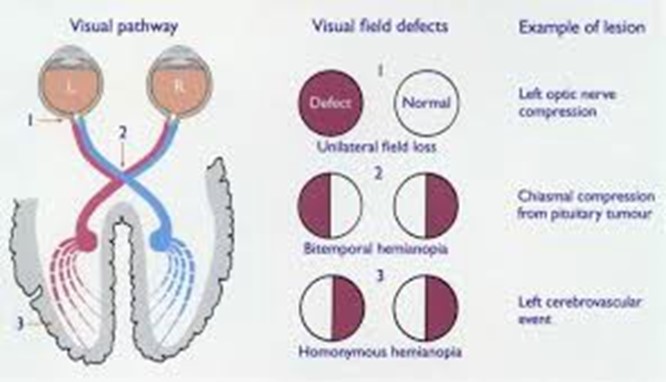A home health nurse is performing an eye assessment for an older adult client. Which of the following findings is the priority for the nurse to report to the provider?
Conjunctivitis
Increased sensitivity to glare
Decreased near vision
Hemianopsia
The Correct Answer is D
Hemianopsia is a visual field defect in which there is a loss of vision in one-half of the visual field. It can be caused by a number of conditions, including stroke, brain tumors, and traumatic brain injury. It is a significant finding that requires immediate reporting to the provider, as it can indicate a serious underlying condition that requires further evaluation and treatment. Hemianopsia can significantly impact a client's ability to perform activities of daily living, mobility, and safety. Conjunctivitis is inflammation of the conjunctiva, which can cause redness, itching, and discharge. While it is important
to assess and treat conjunctivitis, it is not a priority finding that requires immediate reporting to the provider. Increased sensitivity to glare is a common age-related change in vision, and while it can be bothersome, it is not typically a priority finding that requires immediate reporting to the provider. Decreased near vision is another common age-related change in vision, and while it can be an important finding to address with the client, it is not typically a priority finding that requires immediate reporting to the provider.

Nursing Test Bank
Naxlex Comprehensive Predictor Exams
Related Questions
Correct Answer is B
Explanation
The nurse should first assess the client's understanding of her living situation. Understanding the client's perceptions of her living situation will help the nurse develop an effective plan of care that addresses the client's concerns and priorities. Once the nurse understands the client's perspective, the nurse can help the client develop goals for obtaining shelter, discuss the risks of being homeless, and develop client teaching using a variety of strategies.
Correct Answer is ["B","C","D"]
Explanation
The correct answers are B, C, and D. The nurse should assist the client in using guided imagery, maintain the head of the client's bed in an elevated position after eating, and provide sips of room-temperature ginger ale between meals. Guided imagery can help distract the client from the nausea and promote relaxation.
Elevating the head of the bed after eating can help prevent reflux and nausea. Ginger ale can help relieve nausea and can be sipped slowly between meals. Using seasonings to enhance the flavor of foods is not likely to help with chemotherapyinduced nausea, and cold milk as a meal replacement may not provide enough calories and nutrients.
Whether you are a student looking to ace your exams or a practicing nurse seeking to enhance your expertise , our nursing education contents will empower you with the confidence and competence to make a difference in the lives of patients and become a respected leader in the healthcare field.
Visit Naxlex, invest in your future and unlock endless possibilities with our unparalleled nursing education contents today
Report Wrong Answer on the Current Question
Do you disagree with the answer? If yes, what is your expected answer? Explain.
Kindly be descriptive with the issue you are facing.
